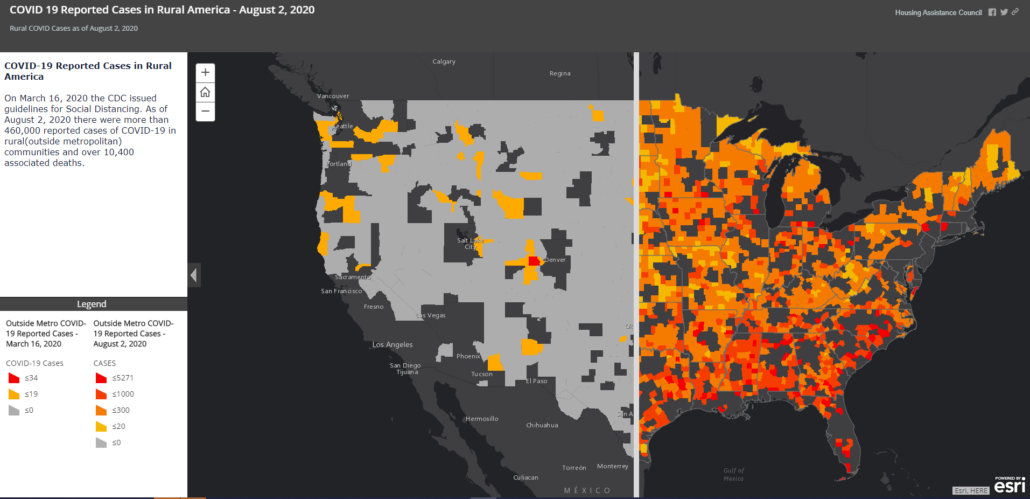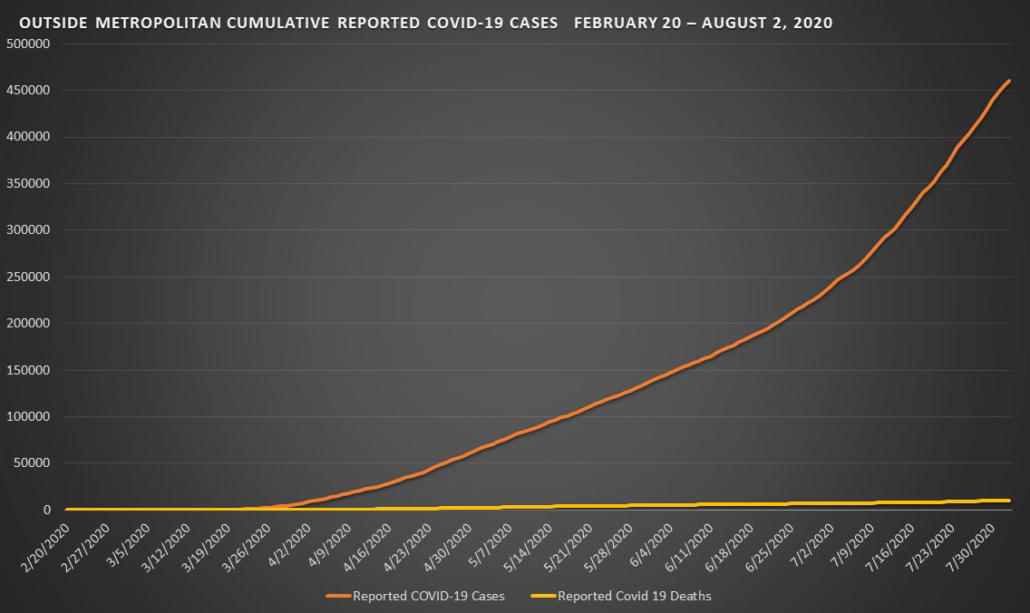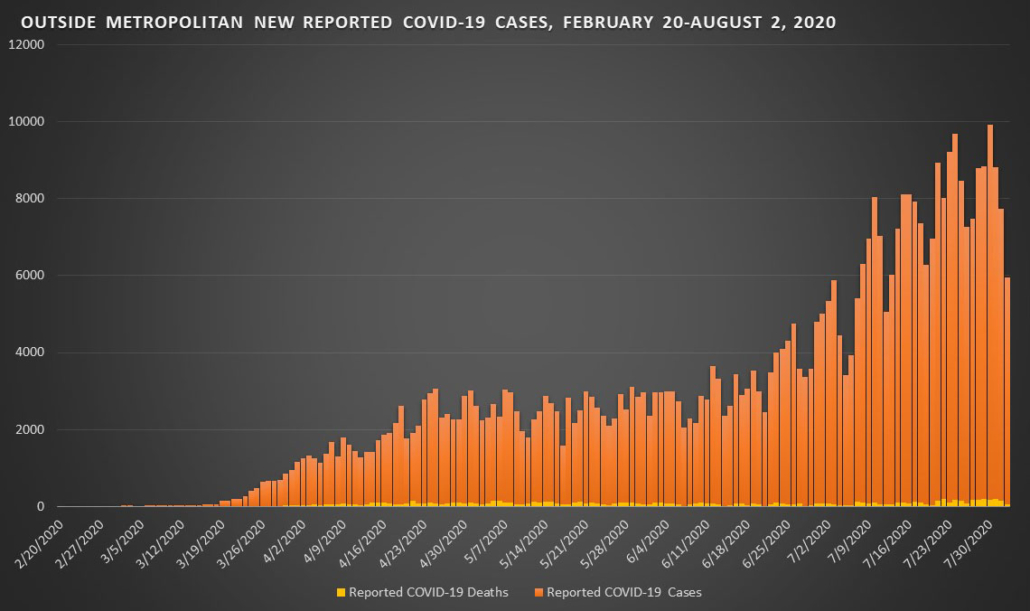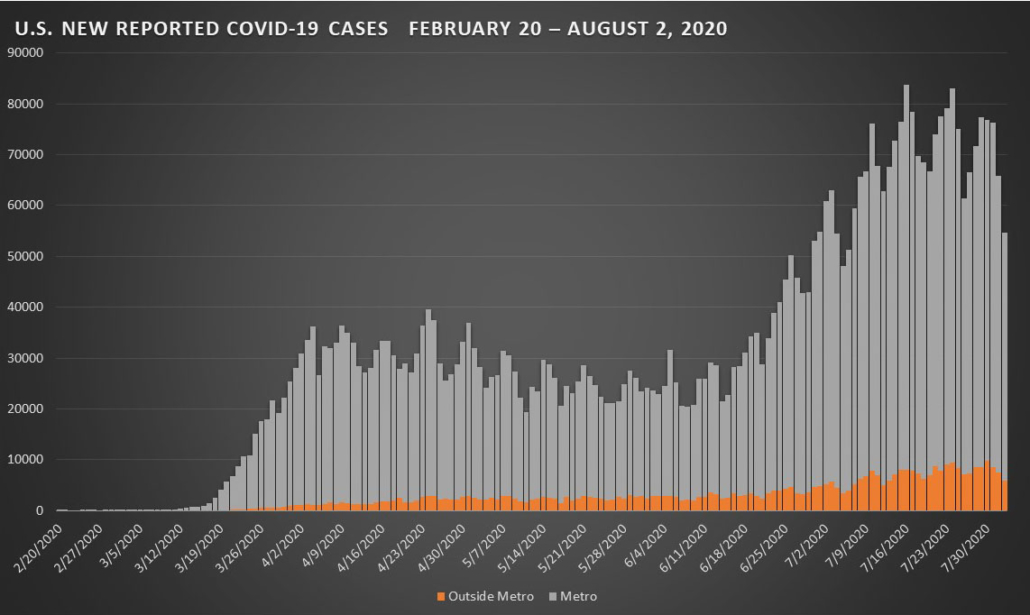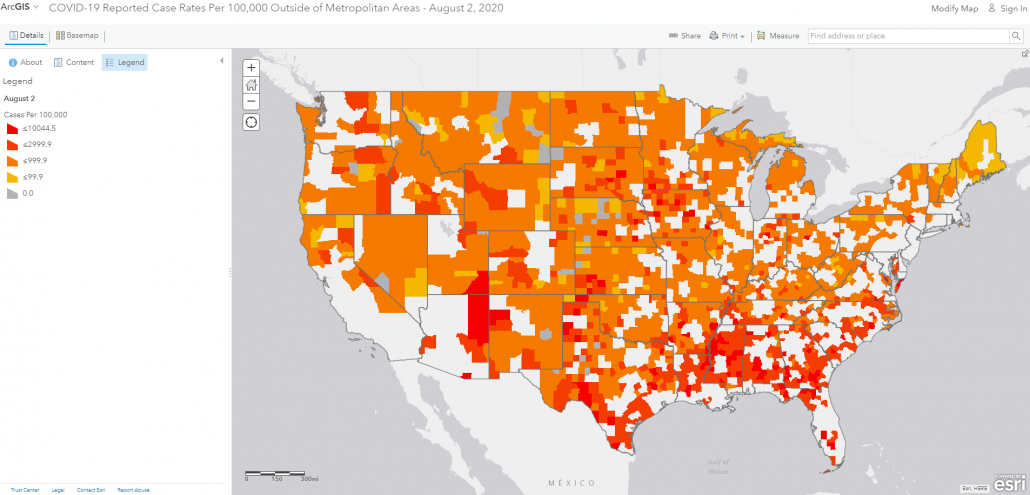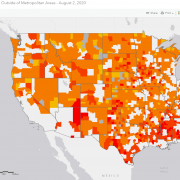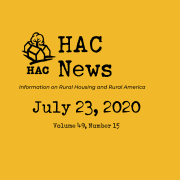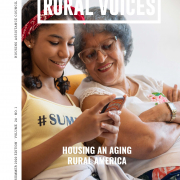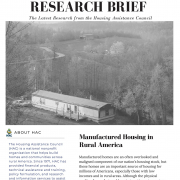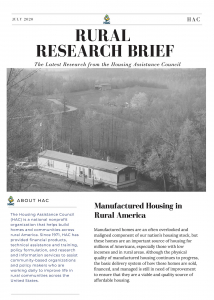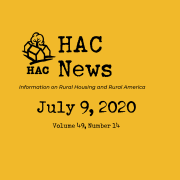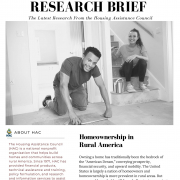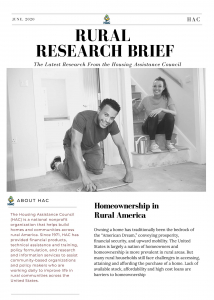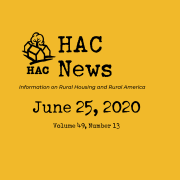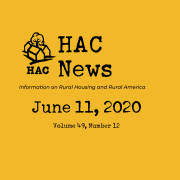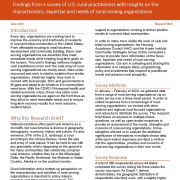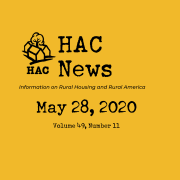HAC News Formats. pdf
July 23, 2020
Vol. 49, No. 15
Eviction protections expiring, lawmakers negotiating.
The Trump Administration and House and Senate leaders are negotiating the next coronavirus relief package, but it is not yet clear what types of aid it will provide, how much or when. HAC spearheaded a sign-on letter from over 100 rural housing stakeholders urging congressional leaders to provide targeted funding for rural communities. Among the reasons for urgency is the imminent expiration of eviction protections while large numbers of low-income tenants are still unemployed or working reduced hours and federal assistance that helped cover housing costs is ending. The CARES Act protects tenants in federally assisted housing from eviction through August 23 (July 24 is the last day of the moratorium and then property owners must give tenants at least 30 days’ notice) and an array of state and local moratoriums have protected some additional tenants for varying amounts of time. One estimate is that 19-23 million people – one in every five people who live in renter households – in the U.S. are at risk of eviction by September. Undocumented people, low-income people, and people of color are the most vulnerable.
USDA and HUD provide new guidance for rental housing as eviction protections end.
Updates to USDA RD’s FAQs for multifamily property owners and managers, HUD Notice H 20-07 and a HUD brochure titled Promoting Housing Stability During the Covid-19 National Emergency: Information for Multifamily Property Owners and Management Agents all address the status of tenant protections as the CARES eviction moratorium expires. A National Housing Law Project analysis compares USDA’s provisions to those of HUD Notice H 20-07.
Administration moving forward to eliminate fair housing processes and transgender shelter protections.
HUD will announce a new Affirmatively Furthering Fair Housing rule on July 23, according to Politico, which reports the department will “essentially rely … on local governments to self-certify that they are ‘furthering fair housing.’” The regulation will not be the one proposed in January and will be issued in final form with no further opportunity for public comment, the article states. A separate proposal to remove current protections for transgender individuals in HUD-supported facilities, such as single-sex shelters or shelters with separate facilities based on sex, will be published in the Federal Register on July 24 with a 60-day comment period. That rule change would allow shelter operators to decide whether to rely on gender assigned at birth or gender identity.
House continues work on FY21 funding for USDA and HUD.
The House of Representatives is scheduled to begin consideration on July 23 of a “minibus” (H.R. 7608) that combines four funding bills for the fiscal year that begins October 1, including USDA (H.R. 7610), State, Interior and Veterans Affairs. The Transportation-HUD bill, H.R. 7616, was approved by the House Appropriations Committee on July 14 and is expected to be part of a second minibus that will be taken up in the House during the week of July 27. The Senate has not yet begun considering appropriations legislation.
USDA requests input on new program for rural job accelerators.
The 2018 Farm Bill authorized a new Rural Innovation Stronger Economy (RISE) program that will make grants to rural job accelerator partnerships to help distressed rural communities create high-wage jobs, accelerate the formation of new businesses and identify and maximize local assets. Public input on the program can be provided in writing or at online listening sessions on July 28 and July 30. For more information, contact Will Dodson, RBCS, 202-762-0592.
RuralSTAT: 456 rural counties do not have a Medicare-registered hospital. Source: Housing Assistance Council tabulation of data from the Center for Medicaid and Medicare Services list of registered hospitals.
Main Street Lending program expands to nonprofits and aids tribal governments.
On July 23 the Federal Reserve expanded its Main Street Lending Program to provide greater access to nonprofit organizations. The program supports lending to small businesses to ensure access to capital during the coronavirus pandemic. In a less publicized change, on July 15 the Fed modified the program’s FAQs to allow tribal enterprises to provide capital distributions to their tribal government owners while participating in the program. They still cannot pay dividends or make distributions to other owners such as individuals. The waiver is important because tribal businesses are owned by tribal governments and distribute some of their income to tribal governments to pay for services to the tribe.
HAC seeks photographers to document U.S. rural housing and development.
With support from the National Endowment for the Arts and honoring the legacy of photographer George Ballis (1925-2010) and his deep ties to rural housing and community development, HAC seeks photographers for an upcoming exhibition, “There Is More Work To Be Done.” Selected photographers will be offered a stipend to document the impact of rural housing and rural community development programs in areas across the country and the work that still needs to be done. Applications are due August 14. For more information, visit HAC’s website or email ballisphoto@ruralhome.org.
Manufactured homes covered in HAC’s newest Rural Research Brief.
Manufactured homes are an often overlooked and maligned component of our nation’s housing stock, but these homes are an important source of housing for millions of Americans, especially those with low incomes and in rural areas. A HAC Rural Research Brief presents data on these homes, their residents and the system through which they are sold, financed and managed.
No change in Fannie Mae and Freddie Mac housing goals proposed for 2021.
Because of the economic disruption resulting from the coronavirus pandemic, the Federal Housing Finance Agency is proposing to keep the benchmarks for Fannie Mae’s and Freddie Mac’s affordable housing goals the same in 2021 as in 2018-2020. Comments will be due 60 days after the proposal is published in the Federal Register. For more information, contact Ted Wartell, FHFA, 202-649-3157.
Housing costs were already out of reach before the pandemic.
The latest edition of the National Low Income Housing Coalition’s annual Out of Reach study compares minimum wages to housing wages – the amount needed to afford the HUD-determined Fair Market Rent for a one-bedroom or two-bedroom apartment. In no state can a person working full-time at the federal minimum wage afford a two-bedroom apartment at FMR. In only 145 of the more than 3,000 U.S. counties can a full-time worker earning the minimum wage afford a one-bedroom rental home at FMR. Data for all states and counties are available from the interactive map posted at https://reports.nlihc.org/oor.
Housing an Aging Rural America.
HAC’s just-published summer 2020 issue of Rural Voices magazine covers the unique challenges – and opportunities – presented by housing for rural seniors. The coronavirus pandemic has also heightened the concern for older and potentially more vulnerable residents, who disproportionally reside in rural America, and makes this conversation more immediate.
Retirements lead to staff changes at USDA RD.
Roger Glendenning, Deputy Administrator of Single Family Housing, is retiring on July 31. Cathy Glover, who has most recently run the Section 502 guarantee program, has been selected to succeed Glendenning. Barry Ramsey, formerly the Director of the Single Family Housing Direct Loan Division and currently the Assistant to the Deputy Administrator, is also retiring on July 31. Brooke Baumann is now the Director of the SFH Direct Loan Division.
Recent publications and media of interest
Need capital for your affordable housing project?
HAC’s loan funds provide low interest rate loans to support single- and multifamily affordable housing projects for low-income rural residents throughout the U.S. and territories. Capital is available for all types of affordable and mixed-income housing projects, including preservation, farmworker, senior and veteran housing. HAC loan funds can be used for pre-development, site acquisition, site development and construction/rehabilitation. Contact HAC’s loan fund staff at hacloanfund@ruralhome.org, 202-842-8600.
Please note: HAC is not able to offer loans to individuals or families. Borrowers must be nonprofit or for-profit organizations or government entities (including tribes).
